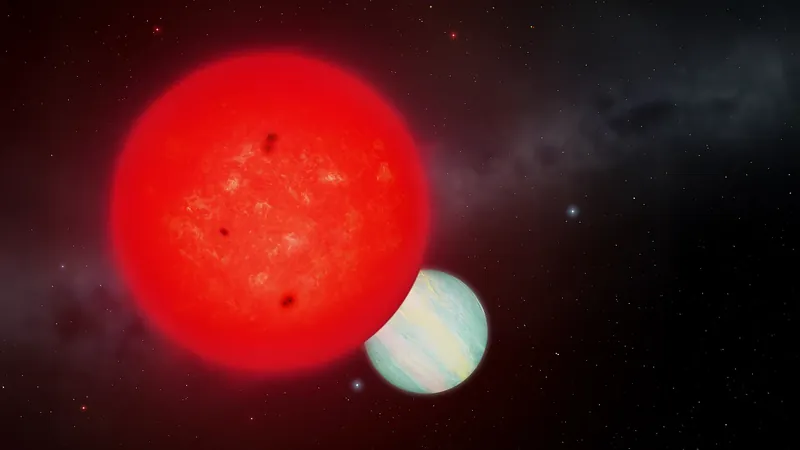
Astronomers Stunned by Discovery of a Giant Planet Defying Cosmic Norms
2025-06-11
Author: Daniel
A Groundbreaking Find in the Cosmos
In a spectacular twist of celestial events, astronomers have uncovered a giant planet, TOI-6894b, orbiting a surprisingly diminutive star—one that shouldn’t be capable of hosting such a massive body. This shocking discovery was detailed in the latest edition of Nature Astronomy by a dedicated team spearheaded by Dr. Edward Bryant from The University of Warwick.
An Unexpected Cosmic Dance
Dr. Bryant, a Warwick Astrophysics Prize Fellow, expressed his thrilled astonishment: "I initially scoured TESS observations of over 91,000 low-mass red-dwarf stars to hunt for giant planets. Finding TOI-6894b, the giant planet circling the lightest known star to host such a planetary companion, challenges everything we believed about star-planet relationships."
What Makes TOI-6894b Unique?
TOI-6894b is not your typical gas giant; it boasts a radius slightly larger than Saturn but weighs in at only about half of Saturn's mass. This places it as a low-density gas giant, and its host star, TOI-6894, stands out as the lightest star recorded with such a planetary companion.
Shifting Paradigms in Planet Formation Theory
Dr. Daniel Bayliss, an Associate Professor at The University of Warwick, stated, "Since most stars in our galaxy are similar to TOI-6894, this discovery significantly widens the scope of potential giant planets in the universe. It forces us to reconsider our understanding of planet formation around low-mass stars."
Challenging the Core Accretion Theory
Current models, especially the prevalent core accretion theory, suggest that forming gas giants around low-mass stars is virtually impossible due to inadequate raw materials. How then does TOI-6894b exist? Dr. Vincent Van Eylen from UCL's Mullard Space Science Laboratory emphasized this point: "This find compels us to rethink existing theories as we don’t fully understand how a small star can foster such a sizable planet."
Unraveling the Mysteries Behind Formation
The mechanisms behind TOI-6894b's creation remain enigmatic, with possible processes ranging from an intermediate core-accretion method to the instability of its protoplanetary disc. Dr. Bryant mentioned, "Neither prevailing theory fully accounts for TOI-6894b's formation, leaving the door wide open for further investigation."
A Unique Atmospheric Profile
On top of its intriguing formation, TOI-6894b’s atmosphere is cooler than most identified gas giants, clocking in at just 420 Kelvin—an anomaly compared to typical hot Jupiters. This peculiar chill offers astronomers a rich opportunity to study its atmospheric composition, which is expected to be dominated by methane and potentially even ammonia.
Eager Eyes on the Universe
Scheduled observations by the James Webb Space Telescope (JWST) within the next year aim to explore TOI-6894b’s atmospheric characteristics, potentially validating new theories of planet formation. Dr. Andrés Jordán from the Millennium Institute of Astrophysics noted, "This discovery presents a perfect avenue to advance our understanding of small stars forming giant planets and establishes new expectations for future cosmic explorations."


 Brasil (PT)
Brasil (PT)
 Canada (EN)
Canada (EN)
 Chile (ES)
Chile (ES)
 Česko (CS)
Česko (CS)
 대한민국 (KO)
대한민국 (KO)
 España (ES)
España (ES)
 France (FR)
France (FR)
 Hong Kong (EN)
Hong Kong (EN)
 Italia (IT)
Italia (IT)
 日本 (JA)
日本 (JA)
 Magyarország (HU)
Magyarország (HU)
 Norge (NO)
Norge (NO)
 Polska (PL)
Polska (PL)
 Schweiz (DE)
Schweiz (DE)
 Singapore (EN)
Singapore (EN)
 Sverige (SV)
Sverige (SV)
 Suomi (FI)
Suomi (FI)
 Türkiye (TR)
Türkiye (TR)
 الإمارات العربية المتحدة (AR)
الإمارات العربية المتحدة (AR)